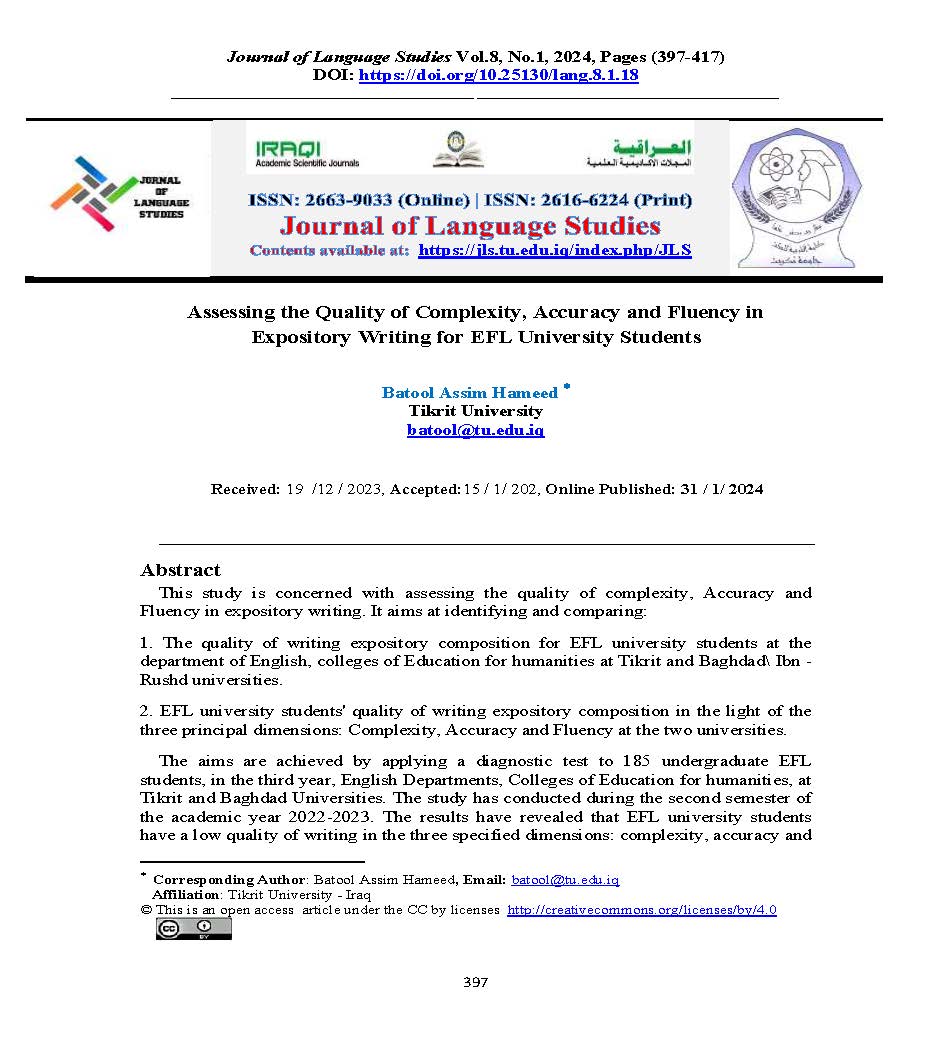Assessing the Quality of Complexity, Accuracy and Fluency in Expository Writing for EFL University Students
DOI:
https://doi.org/10.25130/lang.8.1.18Keywords:
Assessing, Quality, Complexity, Accuracy and Fluency, EFL university Students, WritingAbstract
This study is concerned with assessing the quality of complexity, Accuracy and Fluency in expository writing. It aims at identifying and comparing:
- The quality of writing expository composition for EFL university students at the department of English, colleges of Education for humanities at Tikrit and Baghdad\ Ibn - Rushd universities.
- EFL university students' quality of writing expository composition in the light of the three principal dimensions: Complexity, Accuracy and Fluency at the two universities.
The aims are achieved by applying a diagnostic test to 185 undergraduate EFL students, in the third year, English Departments, Colleges of Education for humanities, at Tikrit and Baghdad Universities. The study has conducted during the second semester of the academic year 2022-2023. The results have revealed that EFL university students have a low quality of writing in the three specified dimensions: complexity, accuracy and fluency. In the light of the results, some conclusions and recommendations have been presented.
References
Abdallah, M.M.S. (2015). Writing II for 2nd Year EFL Student . ………….Teacher (2nd Ed.). Assiut, Egypt: Assiut University ………….College of Education.
Ahmadi, A. and Zahed, A. S. (2017):Language Complexity ………….Accuracy and Fluency in Different Types of Writing ………….Paragraph: Tariq.University, Tehran, Iran, Journal of ………….English Language Teaching and learning. No. 20 /fall ………….and winter 2017.
Alderson, C. (1995) Dictionary of Language Testing. London: ………….CambridgeUniversity Press.
Aljuboory, N. (2014). A Language Teacher's Guide to ………….Assessment. London: Cambridge University Press.
Anderson, M., and Anderson, K. (1997). Text Types in English 2. ………….South Yarra: Macmillan Education Australia PIY LTD.
Archibald, A (2001). Targeting L2 Writing Proficiencies: Instruction ………….and Areas of Change in Students' Writing over Time. ………….International Journal of English Studies,1 (2), (153 ………….174).
Ary, D., Jacobs, L. C.,and Razavieh, A. (2010). Introduction to ………….Research in Education 8th Edition, Wardswoth ………….Cengage Learning. Canada: Nelson Education Ltd ………….Exotic Classic.
Atwell, N. (1987). In the Middle: Writing, Reading, and Learning ………….with Adolescents. Monticlair, Nj: Boynton/Cook.
Cohen, P.;West, S.G and Aiken, L. S. (2014). Applied Multiple. ………….Routledge.
Creswell, J. W. (2012). Educational Research: Planning, ……….Conducting and Evaluating.
Defazio,J.; Jones, J. and Tennant. Importance and Impact of Writing Across the Curriculum. Oxford: Oxford University Press.
Dobao, A. F. (2012). Collaborative Writing Tasks in the ………….L2.Classroom: .Comparing Group, Pair, and Individual ………….Work.Journal.of.Second.Language.Writing,.21(1),405
Donovan R. Walling (2009) Writing for Understanding: ………….Strategies.to Increase Content Learning. USA. Library of Congress .Cataloging in Publication Data.. ………
Ellis, R., and Barkhuizen, G. (2005). Analyzing Learner Language. …………Oxford:.Oxford University Press.
Genesee, F. and Upshur, J. (1996). Classroom-Based ………….Evaluation….in Second Language Education. ………….Cambridge:.Cambridge University Press.
Graham, Steven & Karen R. Harris. (2005). Writing Better: ………….Teaching Writing Processes and Selfregulation to ………….Students .with .Learning. Problems. Baltimore: Brookes.
………….Ishikawa,Sandra.1995.Objective.measurement.of.low ………….proficiency.EFL.narrative.writing.Journal.ofSecond ………….Language Writing 4(1)..51–69.
Hapsari, A. S. (2011). The Use of Roundtable Technique to ………….Improve Students’ Achievement in Writing Hortatory ………….Exposition.Text. Retrieved.from ………….http://lib.unnes.ac.id/6829/1.haspreviewThumbnailVersio…….… n/7894.pdf. October6,2015
Housen, A., and Kuiken, F. (2009). Complexity, Accuracy, and ………….Fluency in Second Language Acquisition. Applied ………….Linguistics,.30(4)461–473.doi:10.93/applin/amp048.
Hyland, K. (2003). English for Academic Purposes: An ………….Advanced Resource Book. Abingdon: Routledge.
Joyce, H., and Feez, S. (2000).Writing Skills: Narrative and ………….nonfiction text types.Sydney; Phoenix Education Pty Ltd.
Lambert, C. – Kormos, J.(2014). Complexity, Accuracy and ………….Fluency Task-based L2 Research: Toward More ………….Developmentally Based Measures of Second Language ………….Acquisition. Applied Linguistics. Vol. amu047, (pp. 1-9), ………….ISSN 0142- 6001.
Larsen-Freeman, D. (2006). The Emergence of Complexity, ………….Fluency and Accuracy in The Oral and Written ………….Production of Five Chinese Learners of English. ………….Applied.Linguistics, 27(4), (pp.590-619).
Lombardo, A. (2010). Purposes of Writing. New York Mc Graw Hill Edu-cation Private Limited.
Madsen, H.S. (1983). Techniques in Testing. New York and ………….Oxford: Oxford University Press.
Mc Arthur, A. C. ;Graham, S., and Fitzgerald, J. (2008).”Hand ………….Book.of Writing a Research”. (6th ed.). New York: The ………….Guildford Press.
Mc Namara, Tim (2000). Language Testing. Oxford: Oxford ………….University Press.
Nosratinia, M. and Razavieh, F. (2016): Writing Complexity ………….Accuracy and Fluency among EFL Learners: ………….Inspecting Their Interaction with Learners' Degree of ………….Creativity Islamic Azad University, Tehran, Iran, DOI: ………….http:// dx. Doi. Org / 10..17507 / types. 0605. 19
Oliva, P. F. and Gordon, II, W. R. (2012). Developing the ………….curriculum. Pearson Higher Ed.
Polio, Charlene G.(1997). Measures of Linguistic Accuracy in ………….Second Language Writing Research. Language Learning ………….47/1..101143.
Raimes, A. (1994). "Techniques in Teaching Writing". Oxford: ………….O.U.P.
Rao, p. (2017) THE CHARACTERISTICS Of EFFECTIVE ………….WRITING.IN ENGLISH LANGUAGE TEACHING. ………….RESEARCH JOURNAL OF ENGLISH (RJOI) VOL- ………….2,ISSUE- 2,
Richards, J. C. (2008) From Meaning into Words: Writing in a ………….Second.or Foreign Language The Language Teaching
………….Matrix.Cambridge: Cambridge University Press, 1990. ………….Print.
Rosas, M. (2000) ''The Level of Difficulty and Discrimination Power ………….of the Basic Knowledge and Skills Examinations''. ………….Available at http://2n0.1/contents- Beckhoff. pdf ………….redieuabc.mx/contenidolvo1.
Santi V. B. (2002)., A Reader for Developing Writers, (New York: ………….McGraw-Hill, 2002), (p. 265).
Skehan, P. (2009). Modelling Second Language Performance: ………….Integrating Complexity, Accuracy, Fluency, and Lexis. ………….Applied Linguistics, 30(4), 510–………….532.doi:10.1093/applin/amp047
Skehan, P., and Foster, P. (1999). The Influence of Task ………….Structure .and Processing Conditions on Narrative ………….Retellings. Language Learning, 49(1), (pp.93–120).
Tai, H. (2015), Writing Development in Syntactic Complexity ………….Accuracy and Fluency, Taiwan, International Journal of ………….Language.and Linguistics.
Wardani, I.,Basic, H. and Waris,A. (2014). Improving the Ability in ………….Writing Descriptive Text Through Guided-questions ………….Technique. E-journal of English Language Teaching ………….Society (ELTS), 2(1), (PP.1-13).
Weir, Cyril J. (2005). Language Testing and Validation. ………….London: Palgrave Macmillan Hampshire
Wolfe-Quintero, K., Inagaki, S., and Kim, H. -Y. (1988). Second ………….Language Development in Writing: Measures of Fluency,.Accuracy & Complexity. Hawai’i, USA: Second Language ………….Teaching & Curriculum Center. Writing Development ………….Centre of Newcastle University. (2016). Features of ………….Academic Writing.

